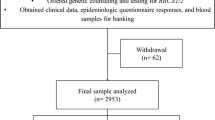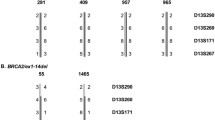Abstract
The Database of Individuals at High Risk for Breast, Ovarian, or Other Hereditary Cancers at the Arizona Cancer Center in Tucson, Arizona assesses cancer risk factors and outcomes in patients with a family history of cancer or a known genetic mutation. We analyzed the subset of clinic probands who carry deleterious BRCA gene mutations to identify factors that could explain why mutations in BRCA2 outnumber those in BRCA1. Medical, family, social, ethnic and genetic mutation histories were collected from consenting patients’ electronic medical records. Differences between BRCA1 and BRCA2 probands from this database were analyzed for statistical significance and compared to published analyses. A significantly higher proportion of our clinic probands carry mutations in BRCA2 than BRCA1, compared with previous reports of mutation prevalence. This also holds true for the Hispanic sub-group. Probands with BRCA2 mutations were significantly more likely than their BRCA1 counterparts to present to the high risk clinic without a diagnosis of cancer. Other differences between the groups were not significant. Six previously unreported BRCA2 mutations appear in our clinic population. The increased proportion of probands carrying deleterious BRCA2 mutations is likely multifactorial, but may reflect aspects of Southern Arizona’s unique ethnic heritage.
Similar content being viewed by others
References
Kurian AW (2010) BRCA1 and BRCA2 mutations across race and ethnicity: distribution and clinical implications. Curr Opin Obstet Gynecol 22(1):72–78
Hall MJ et al (2009) BRCA1 and BRCA2 mutations in women of different ethnicities undergoing testing for hereditary breast-ovarian cancer. Cancer 115(10):2222–2233
Euhus DM (2011) New insights into the prevention and treatment of familial breast cancer. J Surg Oncol 103(4):294–298
Moran A, O’Hara C, Khan S, Shack L, Woodward E, Maher ER, Lalloo F, Evans DG (2012) Risk of cancer other than breast or ovarian in individuals with BRCA1 and BRCA2 mutations. Fam Cancer 11:235–242. doi:10.1007/s10689-011-9506-2
Garber JE, Offit K (2005) Hereditary cancer predisposition syndromes. J Clin Oncol 23(2):276–292
Russo A et al (2009) Hereditary ovarian cancer. Crit Rev Oncol Hematol 69(1):28–44
Fisher B et al (1998) Tamoxifen for prevention of breast cancer: report of the national surgical adjuvant breast and bowel project P-1 study. J Natl Cancer Inst 90(18):1371–1388
Visvanathan K et al (2009) American society of clinical oncology clinical practice guideline update on the use of pharmacologic interventions including tamoxifen, raloxifene, and aromatase inhibition for breast cancer risk reduction. J Clin Oncol 27(19):3235–3258
Lostumbo L, Carbine NE, Wallace J (2010) Prophylactic mastectomy for the prevention of breast cancer. Cochrane Database Syst Rev. doi:10.1002/14651858.CD002748.pub3
Kauff ND, Barakat RR (2007) Risk-reducing salpingo-oophorectomy in patients with germline mutations in BRCA1 or BRCA2. J Clin Oncol 25(20):2921–2927
Bevers TB (2007) The STAR trial: evidence for raloxifene as a breast cancer risk reduction agent for postmenopausal women. J Natl Compr Canc Netw 5(8):719–724
Goss PE et al (2011) Exemestane for breast-cancer prevention in postmenopausal women. N Engl J Med 364(25):2381–2391
Keshavarzi F, Javadi GR, Zeinali S (2012) BRCA1 and BRCA2 germline mutations in 85 Iranian breast cancer patients. Fam Cancer 11(1):57–67
Malone KE et al (2006) Prevalence and predictors of BRCA1 and BRCA2 mutations in a population-based study of breast cancer in white and black American women ages 35 to 64 years. Cancer Res 66(16):8297–8308
Ford D et al (1998) Genetic heterogeneity and penetrance analysis of the BRCA1 and BRCA2 genes in breast cancer families. The breast cancer linkage consortium. Am J Hum Genet 62(3):676–689
Satagopan JM et al (2002) Ovarian cancer risk in Ashkenazi Jewish carriers of BRCA1 and BRCA2 mutations. Clin Cancer Res 8(12):3776–3781
Census U Quick Facts. 2012; Available from: http://quickfacts.census.gov/qfd/states/04/04019.html
InfoGroup, o.b.t.A. Survey: Religion 2009. 2009; Available from: http://www.socialexplorer.com/pub/reportdata/docbrowser.aspx?survey=Religion_InfoUSA09&header=True
BRCA1, I.C. The Breast Cancer Information Core Database. 2012; Available from: http://research.nhgri.nih.gov/bic/
Weitzel JN et al (2005) Prevalence of BRCA mutations and founder effect in high-risk Hispanic families. Cancer Epidemiol Biomarkers Prev 14(7):1666–1671
Acknowledgments
The authors would like to thank Christina Kim, MD for establishing the high-risk clinic database. Corina Mauss performed database entry, Jessica Ray, MS, CGC, Gail Martino, MS, CGC and Zoe Powis, MS, CGC identified, counseled and consented patients and Sam Pinkerton, RN and Stephanie Taylor, RN helped with patient recruitment. This work was supported in part by the Arizona Cancer Center Better Than Ever Program (SKC, ANM), P50CA95060 (CML), U54CA143924 (CML), P30CA023074 (CML, HC, DJR, JMJ), R25TCA078447 (JMJ) and an unlimited use gift from Barry and PatYellen (CML).
Conflicts of interest
The authors report no conflicts of interest.
Author information
Authors and Affiliations
Corresponding author
Rights and permissions
About this article
Cite this article
Nelson-Moseke, A.C., Jeter, J.M., Cui, H. et al. An unusual BRCA mutation distribution in a high risk cancer genetics clinic. Familial Cancer 12, 83–87 (2013). https://doi.org/10.1007/s10689-012-9581-z
Published:
Issue Date:
DOI: https://doi.org/10.1007/s10689-012-9581-z




